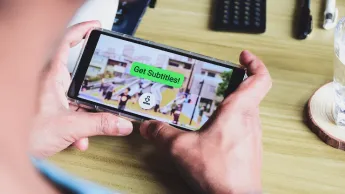Why digital accessibility is everyone's business
- 2024-02-23
- Guest contribution by alumna Aigul Zhalgassova
- Comment

Digital accessibility wasn’t previously an issue for me. A good thing in principle, but not relevant to me – I thought. I used to imagine that the beneficiaries of digital accessibility were mainly people with severe impairments. People like Angelika, for example. I met her at a rehabilitation clinic. Angelika can’t see and uses an app on her mobile phone to read out and dictate text messages. A virtual language assistant provides her with information on weather forecasts or the bus timetable.
My illusion of a world full of people without disabilities evaporated when I myself had hearing difficulties after an ear infection. I was suddenly grateful for the subtitles during web conferences. It wasn’t long before I learned about other people in the company who were hard of hearing, colour blind or who have motor disabilities. I asked myself: what if digital hurdles are an issue for many, or even all of us?
What actually constitutes a disability?
Many people think of accessibility as only being relevant to those who have a disability. But what does that even mean? It became clear to me at a lecture by Annett Farnetani, an expert in digital accessibility, that the term includes a lot more than I imagined. Their disability is immediately visible when people use a walking stick or are sitting in a wheelchair. Mental illnesses including depression or burnout are conversely invisible. I had totally failed to consider such invisible disabilities. Yet they affect almost 28 per cent of the German population – nearly 18 million adults.
I experienced my major light bulb moment, however, when Annett spoke about transitory and situational disabilities. Damaged hands, eye operations, grief, heartache and many other exceptional circumstances can result in individuals not being able to use digital products as they normally would. It makes me think of all fledgling parents who despite sleep deprivation have to fill out electronic forms for local authorities or their employers.
The unavoidable fact of the ageing process is another argument in favour of digital accessibility. Because, whether we like it or not, abilities such as hearing, sight, typing skills and dexterity decline with advancing age. My father is in his mid-sixties and can now only hear with one ear. ‘It just happened so quickly’, he says and is surprised to be suddenly faced with a problem like that. Ageing societies in particular should prepare for this development – also and especially within the digital domain, since that’s where our lives are now predominantly organised.
Innovation through digital accessibility
‘In acquisition conversations, I often hear it said that accessibility blights usability. That’s not the case’, says Farnetani, who manages an agency dealing in accessible digital products. She considers a web-based product that is accessible to people with or without a disability to be a great product for all users. One key criterion for digital accessibility is an interactive design: texts can be enlarged, headings read by screen readers, media can have captions or a transcription.
Are these functions – nowadays taken for granted – not an advantage for us all? We can at least read an image description even with poor internet connectivity. In low light, we enlarge the text or change the colour contrast. The app turns when we’re recumbent and adapts to our position. We watch videos without sound and with captions when we’re travelling.
Innovation patterns repeat themselves
Even early innovations in the field of communication were initially only intended for specific users, but then became accepted as the general standard. The inventors of the first typewriters, such as Pellegrino Turri or Karl Drais, wanted to facilitate communication for their blind friends and family members. The ‘father of email’, Vinton G. Cerf, is hard of hearing and was looking for a way to communicate ideas in writing. Even the automatic word completion by search engines was originally designed for people with motor disabilities. ‘Accessibility alters the product. It becomes better, since many more users can take advantage of it, Annett Farnetani believes.
Let’s stop erecting barriers
My mind dwelt on one point raised in the discussion after Annett’s lecture. Someone said that we shouldn’t be eliminating barriers, but rather stop them being created in the first place. That struck me like a lightning bolt. If we were to build roads planned in advance to have ramps for wheelchairs and pushchairs, or plan fully accessible toilets in every building, then there wouldn’t be a need to eliminate barriers. They simply wouldn’t exist.
The same applies to digital architecture. If product developers designed their products in such a way that as many people as possible could use them, then the issue would no longer exist. Everyone should be free to decide whether or not they visit a website or would like to buy a digital product. Only the desire should be decisive, not the ability. That's true accessibility.
